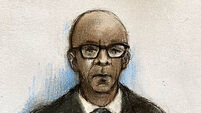Cork photographer Bob Carlos Clarke left behind an enduring legacy

WORKING in the dark room, developing prints of a young and beautiful model, Bob Carlos Clarke turned to his wife. “Isn’t it strange?” he said, “She’s going to get old and crumpled and withered, but I have her in my camera for ever.”
The model has inevitably aged in the intervening years and Carlos Clarke is no longer with us; ten years ago, the Cork-born photographer, best known for his work on chef Marco Pierre White’s book, White Heat, and his dark, iconic images of women in latex and little else, walked out of the Priory in London where he was seeking treatment for depression and threw himself under a train. He was 56.
The world as viewed through Carlos Clarke’s lens gives an insight into a compulsive character in thrall to his own sexuality, with a ceaseless hunger to break free from mundanity. Carlos Clarke’s work is still exciting and filled with romanticism, but for his second wife, life with the enfant terrible required resilience and courage and has left a legacy as enduring as his work.
“I thought marrying someone else would let me escape from being Mrs Carlos Clarke, but it hasn’t really,” Lindsey Carlos Clarke says. Lindsey remarried, to golfer Andrew Daitt, five years ago. Yet when asked how she wants her name printed, she good-naturedly sighs and opts for ‘Carlos Clarke’.
Bob Carlos Clarke was born in the Bons Secours hospital in Cork and lived in Kinsale until he was sent to boarding school at the age of eight. “He was exciting, difficult, dangerous, mercurial and magical,” Lindsey says, and relays a story about him breaking up with an Irish girl who threatened to kill herself; outrageously callous and true to form, Carlos Clarke sent her a live bullet by post, with a message: “This one’s on me.”
“Of course they thought it was IRA-related. So he got in trouble for that one,” Lindsey says. “But then again, he always was a little on the wild side.”
REBEL YELL
Carlos Clarke’s work was a personal rebellion, a deliberate commitment to the unfettered and outrageous: the sensual dynamism of Pierre White cradling a dead shark, the grit and intensity of strippers working inches from the intent, ravenous faces of their clientele. Yet there is also a tension with control; in juxtaposition with his successful commercial work was Carlos Clarke’s exploration of darker worlds of bondage and latex, with women the submissive figures, bound, exposed and manipulated.
“It’s a power trip having a big camera and taking pictures of women, I do understand that,” Lindsey says. She should know; the affair that led to their marriage began in the 1970s, when they were both in other relationships and she, a page 3 girl, agreed to model for Carlos Clarke.
“You were a focus, an obsession,” she says of her time as muse. “All photographers are mad and there’s something that happens between the photographer and the camera and the subject. But part of him wasn’t in control at all; he couldn’t let go of the thing that he photographed.”

Carlos Clarke’s desire to own through the lens was never limited to his wife. She’s breezy, matter-of-fact and open about the pain of sharing a life with a man who jumped from muse to muse.
“In the early days I wasn’t threatened by it, I just didn’t see it but looking back now I can; it was absolutely obsessive,” she says. “It got tiresome. There were times when I knew, when he’d light up with certain models that he’d want to photograph. Sometimes they weren’t even very nice or very interesting and I’d wink at his assistant as if to say, ‘This one will be over in half an hour’.”
IRISH EYES
The Carlos Clarkes continued to visit Ireland while Bob’s mother, Myra, was alive, but stifled and conservative Catholic Ireland was no place for Carlos Clarke’s work. “His soul was Irish but his work was too risqué,” Lindsey says. “He told this story about coming home to Ireland with a box of condoms and being stopped at customs. His parents were waving and smiling at him through the glass as he was having all his condoms confiscated from him.”
Whether it was boarding school, or the 30-year age gap between his parents (His father, Charlie Carlos Clarke, ran away with Bob’s mother, his secretary, at the age of 60 and moved back to Ireland to avoid a scandal), or a genetic predisposition to depression, “It was coming for a long time,” Lindsey says of the depression that took her husband from her. “There was a dark thing inside that I never really understood.”
The ‘dark thing’ also manifested itself in the death of Carlos Clarke’s brother Andrew, six years his junior, whose heroin-related passing followed two years after Bob’s.
In hindsight, it may be easy to attribute signs of Clarke’s depression and desperation to retain control to his final exhibition, 2004’s Love Dolls Never Die. It was Clarke’s first foray into digital photography; although shot on film, the images were processed digitally and Clarke purposefully created a plastic veneer for his models’ flesh. There is an oppressive tone to these Love Dolls; women with on/off switches, aerials and remote controls. Women not only objectified, but objects.

From the forlornly-titled ‘Fantasy Females are Impossible to Satisfy’, to ‘Nookia’, where a vacant-eyed model on a chaise longue is juxtaposed against her image replicated on a mobile phone screen, were there inklings here of Carlos Clarke’s loosening grip, his fear of being ‘past it’. the technological explosion he was witnessing?
“He had worked so hard and had such a long journey and suddenly he felt that anyone could take a picture on their digital camera; he felt that he had honed the skill and it was no longer required,” Lindsey says.
NEW ERA
Ghislain Pascal is the manager of the Little Black Gallery in Chelsea, which is currently hosting an exhibition celebrating Carlos Clarke’s 10th Anniversary, Made in Heaven. It melds some of Carlos Clarke’s best-known images with one-off prints that Carlos Clarke ripped, wrote on and hand-painted.
Pascal worked closely with the photographer for six years and continues to manage his collection with Lindsey and the Carlos Clarkes’ only daughter, Scarlett, 24.
“I felt he was anti-digital because it changed the shooting experience,” Pascal says. “Now, you’re in the studio and everyone can see the pictures instantaneously and everyone comments. That’s not how Bob liked to work.Bob like to work in a very one-on-one relationship based on the connection between the model and photographer, with complete and utter control over the environment.”
“I saw him just before he went into the Priory and he had completely lost control. It was an illness, and a tragedy.” Pascal says.
As part of the continuation of his legacy, Pascal and Lindsey are currently in negotiations to donate several Carlos Clarke pieces to “Irish museums.”
“Ireland never wanted Bob while he was alive, which amused him. The irony is that now he’s dead, you want him back,” Pascal says.








